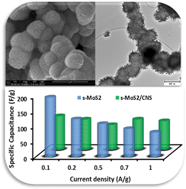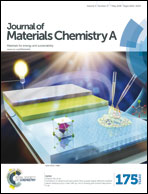Symmetric pseudocapacitors based on molybdenum disulfide (MoS2)-modified carbon nanospheres: correlating physicochemistry and synergistic interaction on energy storage†
Abstract
Molybdenum disulfide-modified carbon nanospheres (MoS2/CNS) with two different morphologies (spherical and flower-like) have been synthesized using hydrothermal techniques and investigated as symmetric pseudocapacitors in an aqueous electrolyte. The physicochemical properties of these MoS2/CNS layered materials have been investigated using surface area analysis (BET), scanning electron microscopy (SEM), transmission electron microscopy (TEM), X-ray diffraction (XRD), Raman, Fourier transform infrared (FTIR) spectroscopy, and advanced electrochemistry, including cyclic voltammetry (CV), galvanostatic cycling with potential limitation (GCPL), long-hour voltage-holding tests, and electrochemical impedance spectroscopy (EIS). The two different MoS2/CNS layered materials exhibit unique differences in morphology, surface area, and structural parameters, which have been correlated with their electrochemical capacitive properties. The flower-like morphology (f-MoS2/CNS) shows lattice expansion (XRD), large surface area (BET analysis), and small-sized nanostructures (corroborated by the larger FWHM of the Raman and XRD data). In contrast to the f-MoS2/CNS, the spherical morphology (s-MoS2/CNS) shows lattice contraction and small surface area with relatively large-sized nanostructures. The presence of CNS on the MoS2 structure leads to slight softening of the characteristic Raman bands (E12g and A1g modes) with larger FWHM. MoS2 and its CNS-based composites have been tested in symmetric electrochemical capacitors in an aqueous 1 M Na2SO4 solution. CNS improves the conductivity of the MoS2 and synergistically enhances the electrochemical capacitive properties of the materials, especially the f-MoS2/CNS-based symmetric cells (most notably, in terms of capacitance retention). The f-MoS2/CNS-based pseudocapacitor shows a maximum capacitance of 231 F g−1, with high energy density 26 W h kg−1 and power density 6443 W kg−1. For the s-MoS2/CNS-based pseudocapacitor, the equivalent values are 108 F g−1, 7.4 W h kg−1 and 3700 W kg−1. The high-performance of the f-MoS2/CNS is consistent with its physicochemical properties as determined by the spectroscopy and microscopy data. These findings have opened doors for further exploration of the synergistic effects between MoS2 graphene-like sheets and CNS for energy storage.


 Please wait while we load your content...
Please wait while we load your content...